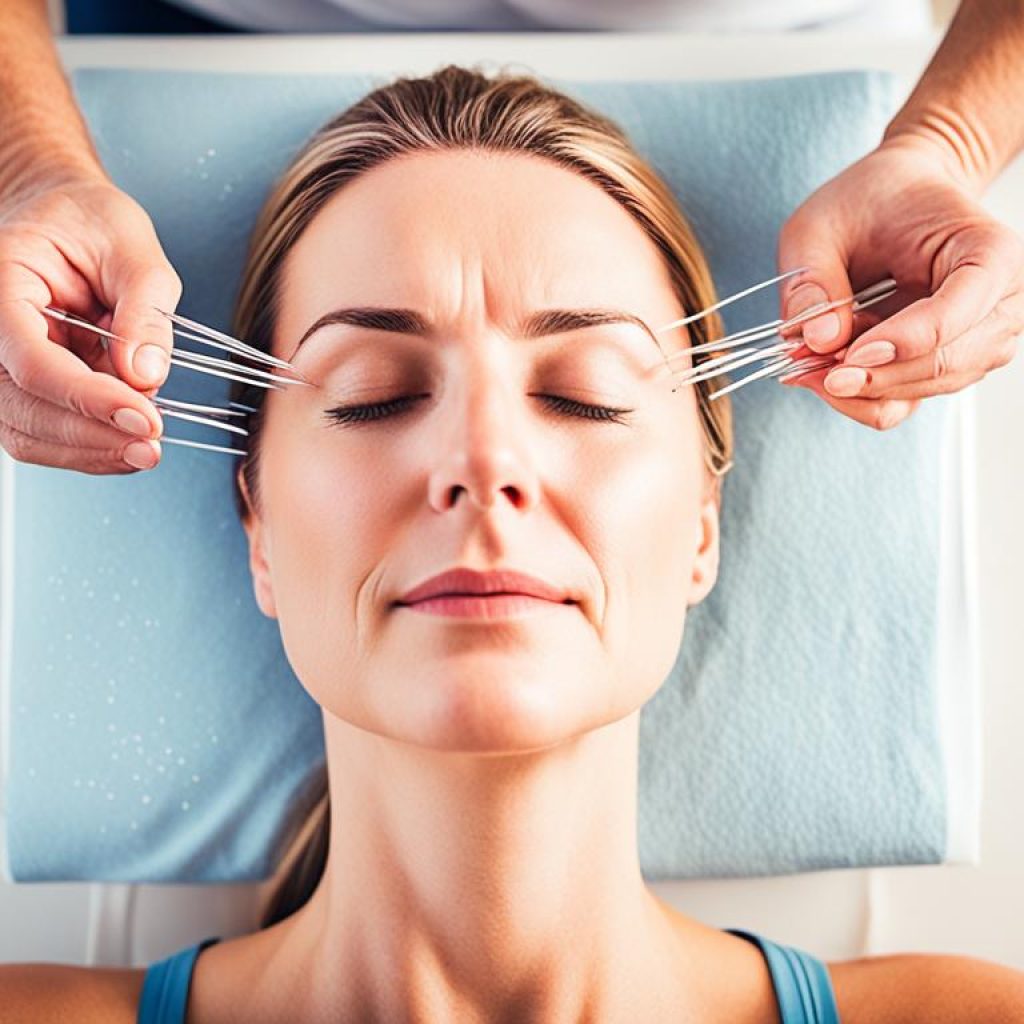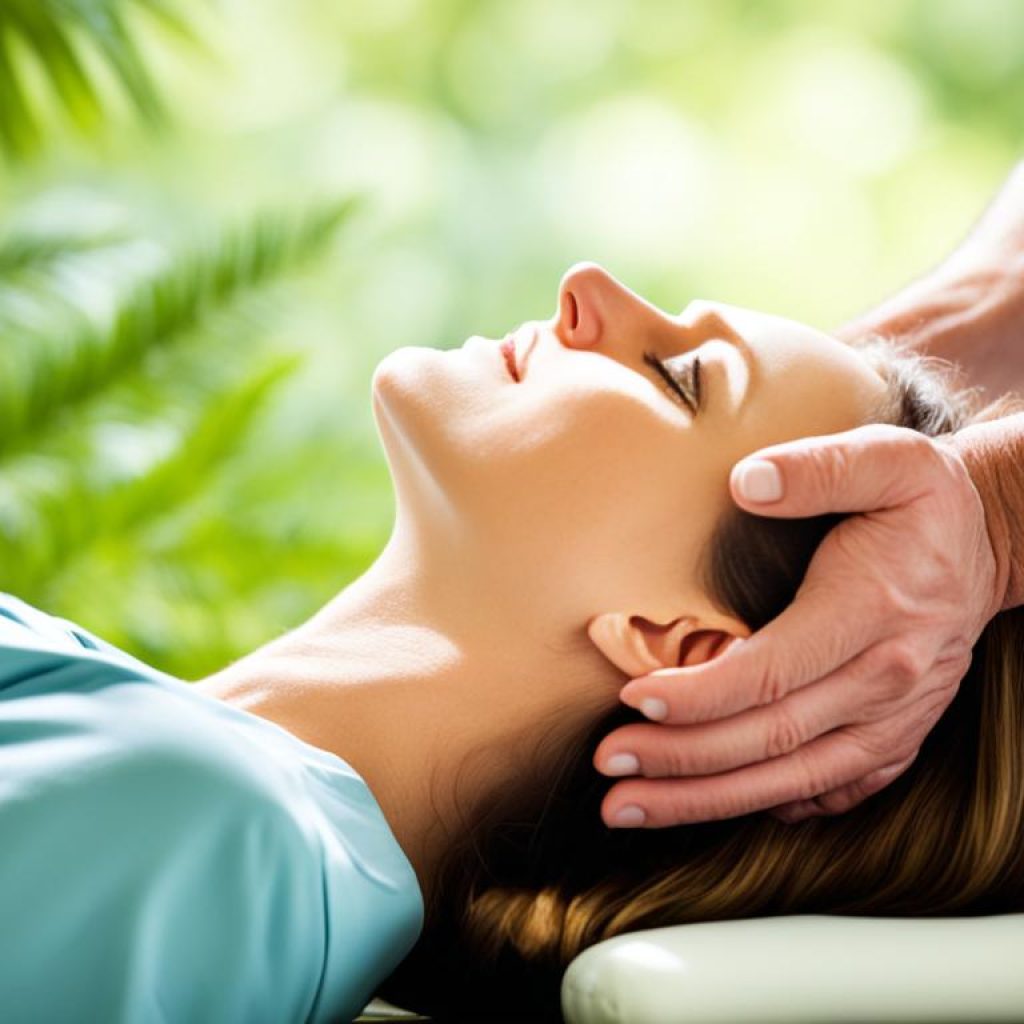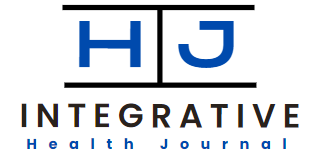Migraines impact around 39 million people across the U.S. alone.
Migraines bring awful pain and make lights and sounds hurt more. They mess with your everyday life. But, using different methods together offers better control and care for migraines than just medicine alone.
This piece talks about how to understand and treat migraines in a complete way. We’ll look into why migraines happen, ways to stop them, and other treatments to help ease the pain and make you feel better all around.
Key Takeaways:
- A complete approach to migraines looks at all possible causes and how to care for them better.
- Trying things like biofeedback, acupuncture, and yoga can really help with migraine pain.
- Learning how to deal with stress, using certain medicines, and practices that connect your mind and body are key in managing migraines.
- Getting advice from experts is important when you are looking into these new ways of dealing with migraines.
- Finding what works best for you means mixing different methods and treatments until you find the right fit.
The Role of Complementary and Alternative Therapies
Migraines can be tough to handle. They often need more than one method for relief. Besides usual medical care, nontraditional options are available. Biofeedback, relaxation techniques, acupuncture, massage, herbal remedies, and dietary changes give extra ways to fight migraines and boost health.
Complementary and alternative medicine comes from various cultures and ideas. They work in different ways but aim to tackle migraine causes and symptoms. Let’s look at some promising nontraditional headache treatments:
- Biofeedback: This method lets people manage body processes that lead to migraines, like muscle tension. With electronic sensors, individuals learn to relax and lessen migraine effects.
- Acupuncture: A practice from Chinese medicine, acupuncture puts thin needles at certain body points to balance and ease pain. Studies show it might change how pain signals work, helping with migraines.
- Massage: Massage’s healing touch aids in relaxation, reduces muscle tightness, and improves blood flow. It focuses on trigger points to help with migraine symptoms.
- Herbal Remedies: Some herbs, like feverfew and butterbur, are being studied for migraine relief. They could be a natural choice for those looking for help. Always talk to a health professional before trying them.
- Dietary Changes: Foods like caffeine, alcohol, and processed items can trigger migraines. Avoiding these and eating nutrient-rich foods might cut down on migraine attacks.
Using complementary and alternative methods along with traditional ones can give more options for relief. By teaming up with health experts and trying out these treatments, people can actively manage their migraines.
“Integrating complementary and alternative therapies into a comprehensive migraine management plan can provide individuals with a broader range of options to find relief.”
Biofeedback for Migraine Relief
Biofeedback uses the mind-body link to reduce migraines. It involves sensors to track your body’s reactions like muscle tension. This gives valuable insights into how your body responds.
A trained expert helps with biofeedback. It allows people to recognize and manage their body signals. They learn how to relax and lower stress. This helps lower muscle tension and stress, which can trigger migraines.
Studies show biofeedback is useful early on for migraine treatment. It can make headaches shorter and happen less often. Using biofeedback, people can identify and manage their body’s reactions to migraines. This helps them find relief sooner.
“Biofeedback helps individuals gain control over their own physiology, allowing them to actively participate in their migraine management. By focusing on reducing muscle tension and stress levels, individuals can experience significant relief and improve their overall well-being.”
Biofeedback is safe and has no side effects. It’s a natural way to deal with migraines without medicine. This method can also complement other treatments for a complete care approach.
Always talk to a healthcare professional before starting biofeedback. They can ensure it’s done correctly. They teach relaxation methods and customize the biofeedback for each person.
Adding biofeedback to your treatment can be really helpful. It lets you take charge of your migraines for better health. By playing an active role, people can control their migraines and feel better long-term.
| Benefits of Biofeedback for Migraine Relief | How it Works |
|---|---|
| 1. Reduces muscle tension | 1. Electronic sensors monitor muscle tension levels |
| 2. Promotes relaxation | 2. Trained specialist guides individuals in relaxation techniques |
| 3. Reduces stress levels | 3. Sensors track skin temperature as an indicator of stress |
| 4. Provides early treatment for migraines | 4. Individuals learn to recognize and address physiological responses |
Botox for Chronic Migraine Treatment
Botox is not just for looking younger. It’s also FDA-approved to treat chronic migraines. If you get migraines on most days each month, it could help you a lot.
Botox blocks pain signals in the brain to reduce migraine pain. It stops certain chemicals in the brain, preventing migraine pain from starting.
Doctors give Botox injections in the head, neck, and upper back for migraines. They choose spots carefully to best treat your pain.
Research says Botox can make migraines happen less often and hurt less. This can really improve life for people with chronic migraines. The treatment usually has few serious side effects.
Only a trained doctor should give you Botox for migraines. They’ll figure out the best dose and where to inject it, especially for you.
In the end, Botox is a proven safe way to fight chronic migraines. It stops pain signals and helps people manage migraines better. If migraines are making your life hard, talk to your doctor about trying Botox.
Thinking about Botox for your migraines? Talk with your doctor. They can tell if it’s right for you, considering your health and history.
| Advantages of Botox for Chronic Migraines | Considerations |
|---|---|
| Botox effectively blocks pain signals in the brain | Botox treatment requires medical supervision |
| Reduces the frequency and intensity of migraines | Treatment should be administered by a qualified healthcare professional |
| Improves the overall quality of life for individuals with chronic migraines | Discuss potential benefits and risks with your healthcare provider |
Stress Management and Antidepressants
Stress, anxiety, and depression often lead to headaches, including chronic migraines. Using stress management and certain antidepressants can help. This approach reduces headache frequency and severity.
Relaxation techniques are key in easing stress. They include deep breathing, guided imagery, and relaxing muscles step by step. Adding these to daily life can lower stress and might stop migraines.
Some antidepressants can also aid in managing migraines. They adjust brain chemicals to lessen migraine attacks. Always talk to a healthcare provider to find the right medicine and dose.
Good sleep habits are important too. Keeping a regular sleep schedule and ensuring a peaceful sleeping area are vital. These steps aid well-being and can cut down on migraines.
Eating well is crucial as well. Choose foods rich in nutrients and avoid migraine triggers like caffeine and alcohol. This healthy lifestyle supports overall health and may decrease migraine attacks.
Those with chronic migraines should get advice from a mental health or medical expert. Specialists can craft treatment plans that blend stress management, antidepressants, and healthy habits. This comprehensive approach can enhance life quality and relieve migraines.
Yoga for Migraine Relief
Yoga combines deep breathing, meditation, and gentle movements. It helps those with migraines. Alongside standard treatments, it can lower migraine frequency and intensity. It’s best to start with gentle yoga, like Hatha, under professional guidance to avoid migraine triggers.
Yoga takes a whole-body approach to reducing migraines and stress. Its exercises, breathing, and meditation relax the body and mind. This can cut down migraine episodes and better your life quality.
Hatha yoga, focusing on easy poses and breath control, suits migraine sufferers. Its calm movements and focus on relaxation fit any fitness level. Practicing Hatha yoga releases tension, boosts circulation, and increases flexibility to prevent migraines.
Guided Poses
To ease migraines, follow specific yoga poses that ease tension and induce calm. Tailored poses can target tight muscles for individuals. Helpful poses include Child’s Pose, Forward Fold, Supine Twist, and Legs Up the Wall.
- Child’s Pose
- Forward Fold
- Supine Twist
- Legs Up the Wall
| Benefits of Yoga for Migraine Relief | |
|---|---|
| 1. Migraine prevention | Yoga can lower how often and how bad migraines are. |
| 2. Stress reduction | Deep breathing and meditation in yoga bring relaxation and less stress. |
| 3. Gentle movements | Hatha yoga’s easy poses work well for migraine sufferers at any fitness level. |
| 4. Breathing exercises | Controlled breathing in yoga calms the nervous system and eases migraine signs. |
| 5. Personal guidance | Learning yoga from a qualified teacher ensures you’re doing it right and avoids migraine triggers. |
“Yoga is a big help for migraine care. It uses movement, breath, and meditation for a calm and stress-low practice. With regular, gentle practice, you can really manage migraines better and boost overall health.”
– Dr. Sarah Collins, Integrative Health Specialist
Always pay attention to how your body feels when doing yoga. If any pose causes discomfort or worsens migraines, change or skip it. A yoga teacher can adjust the practice for your needs and prevent triggers.
Adding yoga to your life offers holistic migraine care and improves life quality. By caring for your mind and body with yoga, you can ease migraines and find peace and wellness.
Acupuncture for Migraine Relief
Acupuncture is a great natural method for easing migraines. It comes from traditional Chinese medicine. Thin needles get inserted at specific body points to help balance the body’s energy and reduce pain. This practice has been around for centuries. It’s now recognized for its ability to help with migraines and more.
Studies show acupuncture may relieve migraines by releasing pain-blocking chemicals. It targets certain points and nerves, helping manage pain better. Regular visits to an experienced acupuncturist can help keep migraine symptoms at bay, offering lasting relief.
Seeing an experienced acupuncturist is key. They ensure the procedure is safe by using sterilized needles. Choosing a qualified professional gives you peace of mind. You know you’re in good hands, receiving skilled care.
Acupuncture involves the insertion of thin needles into specific points on the body to balance energy flow and relieve pain.
Besides migraine help, acupuncture is safe and non-invasive. It’s often seen as relaxing and refreshing. Acupuncture works well on its own or with other therapies, giving a complete healing experience.
Thinking about acupuncture for migraines? Make sure to go to an experienced acupuncturist who knows about treating migraines. They’ll assess your situation and tailor a plan just for you. With their help, you can uncover acupuncture’s benefits and get real migraine relief.
| Benefits of Acupuncture for Migraine Relief | Factors to Consider |
|---|---|
| Stimulates the release of pain-blocking chemicals | Experience of the acupuncturist |
| Regulates pain signals | Sterilization practices |
| Promotes overall well-being | Safety precautions |

Think of acupuncture as a natural way to fight migraines. It uses ancient Chinese practices to balance energy, lessen pain, and boost well-being. With a skilled acupuncturist’s help, you can control migraines better and enjoy life more.
Acupressure for Migraine Relief
Acupressure comes from acupuncture and helps ease migraine pain naturally. By pressing certain body points, you can relax muscles and lessen stress. This balance of energy helps reduce tension linked to migraines.
This method is a drug-free way to handle migraines right at home. Regular self-massage at specific points can cut down migraine symptoms. It also brings relaxation and relief.
Key Pressure Points for Migraine Relief
| Pressure Point | Location | Technique |
|---|---|---|
| Feng chi | At the base of the skull, in the hollows on either side of the neck | Gently press and massage using small circular motions for 2-3 minutes |
| Jian jing | On the tops of the shoulders, directly above the armpits | Apply firm pressure using the fingertips for 1-2 minutes |
| He gu | On the web between the thumb and index finger, in the fleshy mound | Apply deep pressure with the thumb of the opposite hand, massaging in circular motions for 2-3 minutes |
| Zhong zhu | On the back of the hand, in the web between the pinky finger and the ring finger | Apply gentle pressure using the thumb of the opposite hand, massaging in small circular motions for 1-2 minutes |
Remember, acupressure might not work for everyone. It’s best to check with a doctor or a trained professional before trying it yourself.
Adding acupressure to your routine can help manage migraines. It relieves tension, relaxes muscles, and improves your wellbeing.
Chiropractic Care for Migraine Relief
Chiropractic care is a holistic way to deal with migraines. It works by adjusting the spine, joints, and muscles. Chiropractors use their hands or special tools to ease pain and promote health. They focus on making migraines less frequent, intense, and short.
Studies show that chiropractic spinal manipulation can improve migraines. It adjusts the spine and joints to better align them. This eases tension and boosts the nervous system’s function, leading to fewer migraine symptoms.
Chiropractors also use muscle therapies for migraine causes, like tight muscles. They might massage, stretch, or apply other techniques to soothe and loosen the muscles.
Besides working on your body, chiropractors give advice on how to live to prevent migraines. They can suggest ways to sit or work better, exercises, and how to relax. This whole-life approach helps tackle factors that trigger migraines.
Chiropractic care should be one part of a bigger plan for fighting migraines. It works best when combined with other treatments. This can include medicine, stress relief, and changing your diet for the best migraine control.
Chiropractic Care Benefits for Migraines:
- Spinal and joint manipulation: Corrects misalignments to improve nerve functions.
- Muscle therapies: Eases muscle tensions and stiffness.
- Lifestyle recommendations: Advises on better posture, work habits, and relaxation.
- Complementary approach: Pairs chiropractic care with other migraine treatments.
If you’re looking for a non-invasive and drug-free way to address migraines, consider chiropractic care. Always talk to a professional chiropractor to tailor a treatment that fits your needs.

Mind-Body Techniques for Migraine Relief
Mind-body techniques are great for well-being and easing migraines. They use the strong link between mind and body for relief. With methods like biofeedback, mindfulness, hypnosis, relaxation training, and cognitive behavioral therapy, people can tackle migraines in a whole-person way.
The Power of Biofeedback
Biofeedback lets people manage their body functions. It uses sensors to track things like muscle tension and skin temperature. This shows how the body reacts to stress and migraine triggers. People learn to relax muscles and cut stress, stopping migraines before they start.
The Practice of Mindfulness
Mindfulness means paying attention to now and understanding our thoughts and feelings. It helps with stress and migraine symptoms. Making mindfulness a daily habit brings pain relief, lessens migraines, and boosts well-being.
Hypnosis for Migraine Relief
Hypnosis puts you in a deeply relaxed and focused state. A trained guide helps you reach your subconscious to change thoughts linked to migraines. Using suggestions and relaxation, hypnosis can lessen migraine pain and how often they happen.
Relaxation Training: Unwinding the Body and Mind
Relaxation training teaches ways to relax both mind and body. Methods include deep breathing, muscle relaxation, and imagining peaceful scenes. Using these techniques daily can decrease stress and anxiety, managing migraines better.
Cognitive Behavioral Therapy: Changing Thought Patterns
Cognitive Behavioral Therapy (CBT) shifts harmful thought and behavior patterns. With a therapist’s help, you learn new ways to cope, challenge negative thoughts about migraines, and react better to triggers. CBT changes how you view pain, reduces stress, and improves life quality.
“Mind-body techniques give us the power to manage migraines and better our well-being. Adding biofeedback, mindfulness, hypnosis, relaxation training, and CBT to our lives means real migraine relief and taking back our health.”
| Technique | Description | Benefits |
|---|---|---|
| Biofeedback | Monitoring physiological signals to regulate muscle tension and stress levels | Reduced migraine frequency and severity, enhanced stress management |
| Mindfulness | Bringing attention to the present moment, reducing stress and enhancing coping mechanisms | Improved pain management, reduced anxiety, enhanced overall well-being |
| Hypnosis | Creating a state of deep relaxation and altering thought patterns associated with migraines | Reduced migraine frequency and severity, enhanced relaxation |
| Relaxation Training | Utilizing techniques such as deep breathing, progressive muscle relaxation, and guided imagery | Reduced stress levels, improved relaxation, enhanced overall well-being |
| Cognitive Behavioral Therapy | Identifying and modifying thought patterns and behaviors associated with migraines | Improved coping mechanisms, reduced pain perception, enhanced quality of life |
Conclusion
In conclusion, combining traditional medical treatments with alternative therapies provides a full plan for migraine relief. Using methods like biofeedback, acupuncture, yoga, and chiropractic care helps people find personal ways to ease migraine symptoms. This also improves overall well-being.
This approach looks at migraines from all angles. It deals with the symptoms, root causes, and triggers. By using a mix of techniques, people can understand their migraines better. This helps them find the best ways to manage their condition.
From relaxation methods to dietary adjustments, there are many options for those suffering from migraines. The holistic method considers each person’s unique needs. This makes it a more thorough and successful way to handle migraines.

